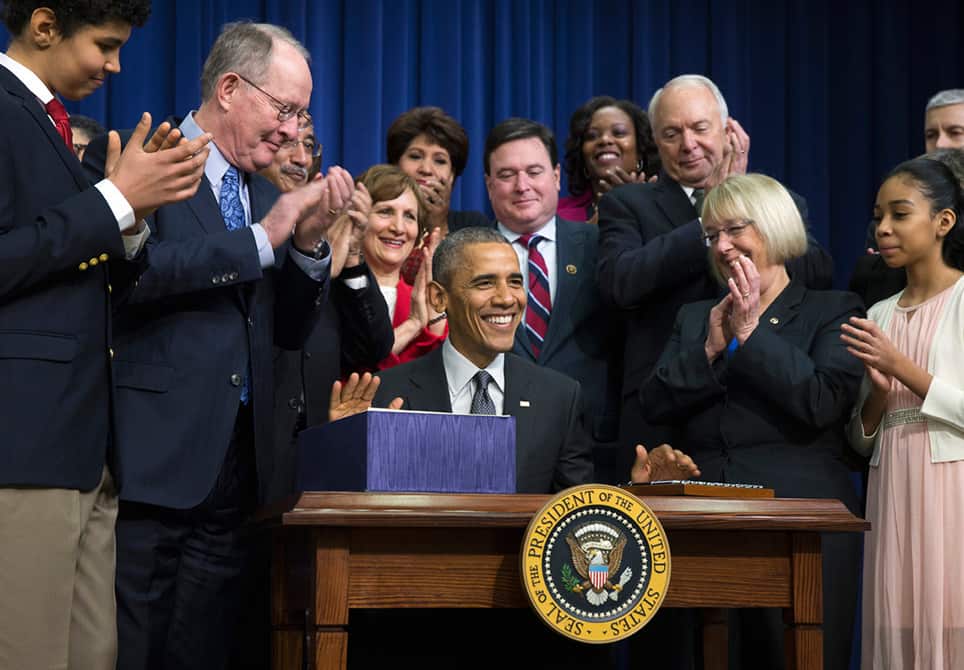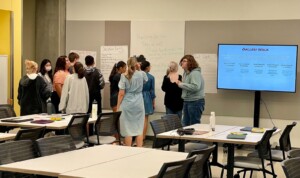New K-12 Federal Education Bill Signed into Law: ESEA Is Reauthorized

It’s official… No Child Left Behind is no more. Say hello to the Every Student Succeeds Act (ESEA). In this blog that first appeared on iNACOL.org, Susan Gentz, State Policy Associate with iNACOL, shares how we got here, ESEA implications, and information on the new National Education Technology Plan and the Future Ready Pledge.
Susan Gentz
President Obama signed into law a bill that reauthorizes the Elementary and Secondary Education Act. The Every Student Succeeds Act (ESSA) replaces No Child Left Behind and holds significant implications for the field of K-12 education.
RT if you agree: Every child, regardless of race, income, or zip code, deserves a shot at a great education. #ESSA https://t.co/vicVvASRNd
— The White House (@WhiteHouse) December 10, 2015
This is the beginning of a new era of education policy in the US. ESSA gives states flexibility to redesign assessments for student centered learning, to rethink accountability for new learning models, and to modernize educator and leadership development. It also provides funding to states and districts to implement personalized learning and invests in research on the digital equity gap.
Every Student Succeeds Act Signed Into Law
On December 2, 2015, ESSA passed the House of Representatives by a vote of 359-64. The Senate followed suit on December 9, 2015 and passed the historic bill by a vote of 85-12.
#ESSA passes 85-12. Next stop: Presidential signature. This is happening!
— Maria Worthen (@mariaworthen) December 9, 2015
President Obama then swiftly signed the bill into law on December 10, 2015.
WHAT ESSA DOES:
- Shifts the federal role in education policy to increase state authority and support local decision-making;
- Provides states flexibility to redesign assessments for student-centered learning;
- Establishes a new Innovative Assessment Pilot program to allow states to pilot new systems of assessments that align to competency education;
- Requires states to report annual student academic performance by subgroup and have a plan for intervening in the lowest performing schools to ensure equity;
- Removes NCLB’s “highly qualified teacher” requirement, allowing states to redefine what it means to be an effective educator;
- Provides funding to states and districts to implement personalized, blended, and online learning including professional development and learning infrastructure; and
- Asks the Institute of Educational Sciences to study the barriers to students’ home internet access for anytime/anywhere learning.
To learn more about this bill, tune in for “The Every Student Succeeds Act—How Will the New Federal K-12 Education Law Support Personalized Learning?” webinar next week on Wednesday, December 16, 2015, from 3:00 PM to 4:00 PM EST. Register here.
White House Releases the 2016 National Education Technology Plan
On Thursday, December 10, the White House and the US Department of Education released the 2016 National Education Technology Plan (NETP) titled: Future Ready Learning: Reimagining the Role of Technology in Education.
New #NETP – Future Ready Learning: Reimagining the Role of Technology in Education! https://t.co/o5TS6TxBpW #edtech pic.twitter.com/OVzIOxIy2r
— Carri Schneider (@CarriSchneider) December 10, 2015
The goal of the NETP is to set a national vision and plan for learning enabled by:
- Technology through building on the work of leading education researchers; district, school, and higher education leaders;
- Classroom teachers; developers; entrepreneurs; and
- Nonprofit organizations.
The 2016 plan builds off of the previous report (released in 2010) by showing how the conversation has shifted. Some of the examples include:
- The conversation has shifted from whether technology should be used in learning to how it can improve learning to ensure that all students have access to high-quality educational experiences.
- Sophisticated software is allowing us to adapt assessments to the needs and abilities of individual learners and provide near real-time results.
- Technology has allowed us to rethink the design of physical learning spaces to accommodate new and expanded relationships among learners, teachers, peers and mentors.
The NETP also points out where there is room to improve, citing:
- A digital use divide continues to exist between learners who are using technology in active, creative ways to support their learning and those who predominantly use technology for passive content consumption.
- Many schools do not yet have access to or are not yet using technology in ways that can improve learning on a daily basis, which underscores the need to accelerate and scale up adoption of effective approaches and technologies.
- Few schools have adopted approaches for using technology to support informal learning experiences aligned with formal learning goals.
Future Ready Pledge
The US Department of Education is encouraging superintendents to take the Future Ready Pledge to work with educators, families, and community members to make all schools in their districts Future Ready.
By taking the Future Ready pledge, superintendents are committing to support new learning models and ensure that more students will graduate from high school ready for college and career. This will help to align policy and practice, and illuminate the path forward in K-12 education transformation.
What items do you want to see in iNACOL’s next policy update? Please comment or Tweet us,@nacol and sign up for our newsletter.
For more on federal policy, check out:
- Eight Ways Federal Policymakers Can Support Student-Centered Learning
- The iNACOL Federal Policy Frameworks 2015
Stay in-the-know with all things EdTech and innovations in learning by signing up to receive the weekly Smart Update. This post includes mentions of a Getting Smart partner. For a full list of partners, affiliate organizations and all other disclosures please see our Partner page.
Image via Evan Vucci/AP



0 Comments
Leave a Comment
Your email address will not be published. All fields are required.